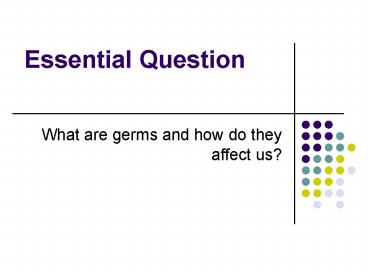Essential Question - PowerPoint PPT Presentation
1 / 22
Title:
Essential Question
Description:
What is the one thing that all viruses have in common? ... Define bacteriophage. Viruses that infect bacteria. Describe the lytic cycle. ... – PowerPoint PPT presentation
Number of Views:38
Avg rating:3.0/5.0
Title: Essential Question
1
Essential Question
- What are germs and how do they affect us?
2
- Virus is the Latin name for poison.
3
- What is the one thing that all viruses have in
common? - All viruses enter living cells and use the cells
machinery to produce more viruses.
4
What do viruses infect?
- Cells of living things
- Viruses are specific to the cells they infect.
- The cell the virus infects is called a host cell.
- Any particle that causes disease is called a
pathogen.
5
What do viruses infect?
- Cells of living things
- Viruses are specific to the cells they infect.
- The cell the virus infects is called a host cell.
- Any particle that causes disease is called a
pathogen.
6
What is the size of a virus?
- Viruses are very small. (electron microscope)
- 17nm 100 nm (.00000004 inches)
- 950,000 viruses end-to-end would fit across a
penny 9,500,000 viruses end-to-end would fit
along the length of a pencil! - SHAPE Viruses come in a variety of shapes
- Helical
- Polyhedral
- Spherical
- Spacecraft-like
7
HELICAL VIRUS
Influenza Virus (Flu)
8
POLYHEDRAL VIRUS
Lymantria dispar Multinucleopolyhedrosis Virus
9
(No Transcript)
10
(No Transcript)
11
Define bacteriophage
- Viruses that infect bacteria.
12
Describe the lytic cycle.
- 1. Virus enters the cell.
- 2 Virus takes over the host cell and starts
making copies using the cells machinery. - 3. Cell bursts.
- bad houseguest
- Animation
- Viruses that undergo this cycle are said to be
virulentthis means they cause disease.
13
- Viruses that undergo this cycle are said to be
virulentthis means they cause disease.
14
(No Transcript)
15
Describe the lysogenic cycle. (permanent
houseguest)
- 1. The virus enters the cell.
- 2. Viral DNA combines with host DNA forming a
new set of genes. (provirus) - 3. When the host cell replicates the cells DNA,
it also replicates the provirus. - 4. New virus particles are not assembled and the
host cell is NOT destroyed. - After many months, years, etc., the provirus may
leave the hosts DNA and enter the lytic cycle. - KEY The cell does not burst right away.
- Animation
16
(No Transcript)
17
(No Transcript)
18
Name 5 diseases caused by viruses
- Chicken pox
- Mumps
- Rabies
- AIDS
- HIV
- Polio
19
What is a retrovirus? Name a virus that is a
retrovirus.
- A retrovirus is a virus that makes DNA from RNA.
- HIV
20
What is the function of a vaccine?
- Weakened or killed virus or viral proteins.
- Stimulates the body to create antibodies.
- Medications only provide relief from symptoms.
21
Are viruses alive?
- Viruses are not alive. They do not have all the
characteristics of life.
22
HIV and AIDS
- Retrovirus
- HIV infects cells that help our body fight
disease. (T4 cells or Helper T cells) - Most people die from other infections.
- Transmitted through direct contact through bodily
fluids. - Spherical
- 120 nm (60 times smaller than a RBC)































